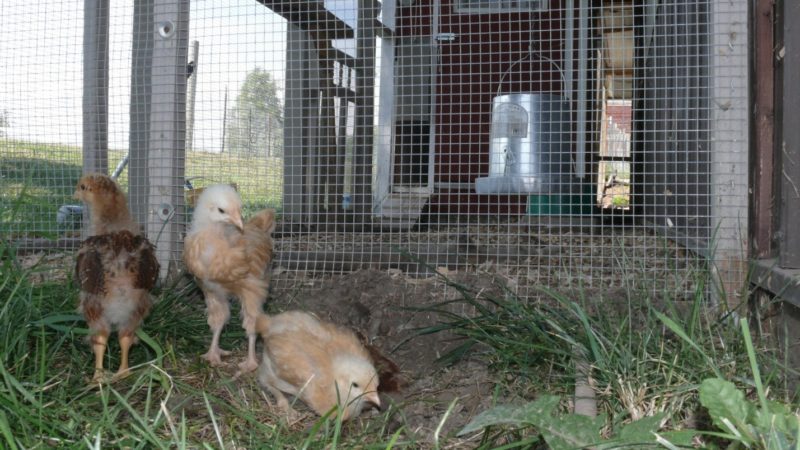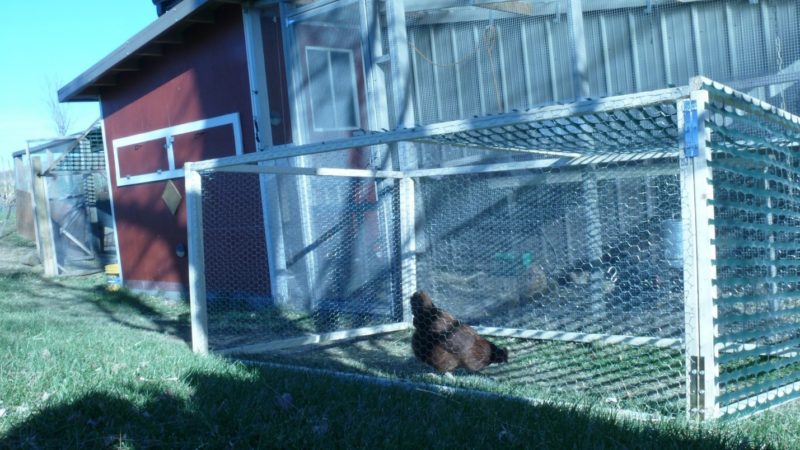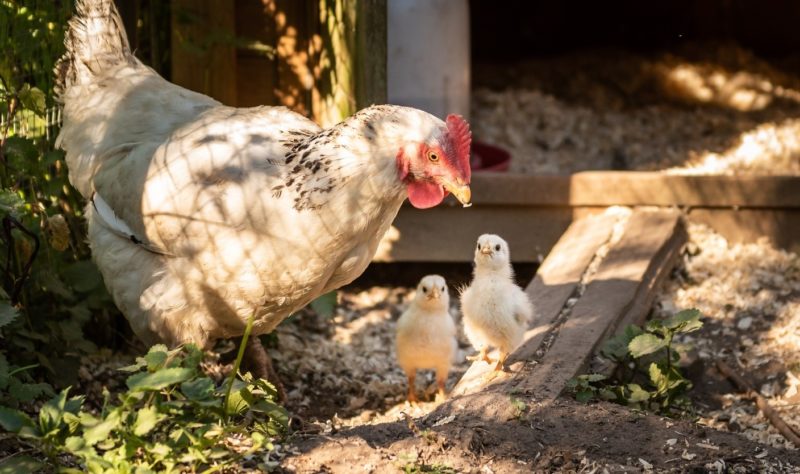at what age can i introduce chicks to the older flock
Excited about new chicks, but nervous virtually introducing them to your existing flock? Elizabeth Mack walks you through bird dynamics to proceed everyone safe.
Bringing new chicks domicile can be a stressful time, but it's especially nervus-wracking when you have an existing flock. The one-time girls are prepare in their ways, know their place, and have a routine. Throw in a new mix of chicks, and everything is thrown into disarray. Fights tin can break out, and blood is often shed. While y'all tin't avoid some pecking and fighting when integrating new chicks, understanding flock dynamics and taking it wearisome will assistance you lot avert at to the lowest degree some of the chicken battles.
Introductions
I take a friend who throws all of his new young hens in with the older girls and lets them fight it out until the feathers settle, which tin take weeks. While this is one way to integrate new additions, information technology can as well be a bloody ane. I prefer to slowly acclimatize new additions to avert as much mortality equally possible — and to lessen my ain stress!
Assuming you lot don't accept a broody hen to female parent — and protect — the babe chicks, keep new chicks in their own brooder space for the first few weeks. One time temperatures are warm enough to spend some time outside, I'll accept my chicks to meander next to the former girls' enclosed run. It's their starting time opportunity to meet the older hens, only through the safety of the enclosed fencing. It's also fun to watch them walk on grass for the get-go time!

Chicks are out for a short visit beside the big pen. They'll proceed to go back to their brooder until they're fully feathered. Photo by author.
The older hens will be naturally curious and maybe a bit threatened by these new girls. They might strut back and forth and squawk loudly. This is their way of showing dominance over the immature chicks. Allow them the opportunity to spend time effectually each other, but safely separated, which will permit the older hens to meet the new chicks and lessen the threat of newcomers.
Separate Pens
At about 4 to 6 weeks onetime, chicks will begin to get their feathers and tin can maintain their body temperature. If the atmospheric condition allows, I'll put them outside in a "playpen." This pen is simply a temporary run where they'll spend the day, situated right beside the larger run. This slow acclimation process serves to permit the new and established flock get to know each other. Each forenoon, I place the chicks in the outside temporary run and permit them spend the 24-hour interval next to their future home.

This pullet is prepare to go into the pen with the large girls. Photo by author.
At first, the older hens might "defend" their territory by standing guard over the strange newcomers. But once they get used to seeing the newbies, hopefully daily for a couple of weeks, they'll go on well-nigh their business concern. I let my new chicks play exterior in the temporary pen for virtually 2 weeks, long enough to get both the new flock and the older flock used to each other. The pen is temporary, so it's not predator-proof. In the evening, I take them within the garage to their brooder pen.
Is this a lot of work? Yes. But after some failed attempts at integration, the actress work is worth it.
Moving Twenty-four hour period
Much debate exists on how old chicks should be before integrating with an existing flock. Should y'all integrate when chicks are smaller so they won't appear as much of a threat, or await until they're bigger and on more of an equal footing to the older hens?
New chicks have to be big enough to defend themselves from the older hens. Otherwise, they could exist pecked to death by on overly aggressive hen. I've integrated too early, and regretted it. Now, I wait until the new girls are almost the same size as the older hens. Past that fourth dimension, they'll have spent some time in their temporary run, and the established flock volition be used to them being around.
In one case they're big plenty, I put the new girls into the run with the flock for some daytime bonding. This is a chaperoned outcome, when I hang around to make sure there's no aggressive fighting. Before I put them in the pen together unsupervised, I make sure the younger hens have shelter and hiding places to become away from a pecking hen if needed. I besides put out boosted waterers and feeding stations so battles over mealtime volition lessen.
Pecking Guild
New chicks will learn quickly most the established pecking order. The older hens will see to information technology. Trying to cut the line for food or water will be met with a swift peck. Assuming at that place's no rooster in accuse, the flock will always have a dominant hen. Chickens instinctually alive in a hierarchal community. All members of an established flock know their place — when to swallow, where to dust bathe, when it'southward their plow to become to roost, where to roost — and every element of flock dynamics are established by this pecking social club.

A mama hen volition protect her chicks, only baby chicks with no mother hen should be integrated slowly. Photo past Pixabay.
When new chicks are introduced into an established flock, the hierarchal society is thrown into disarray. Chickens don't like change, and are sensitive to stressors. Older hens might stop laying from the stress of newcomers. When they're stressed, they can also get aggressive by pecking, pulling feathers, fluffing their feathers, and even mounting other hens. Once the aggressiveness turns bloody, it tin can quickly turn deadly, as the flock will be attracted to the sight of claret, and can peck the injured craven to death. When integrating, information technology'due south a expert idea to keep a wound kit on hand with styptic powder to end bleeding.
While all of this sounds barbaric to humans, it's a flock'southward manner of creating social club, a "authorities" that'south worked since the kickoff of chicken time. The chickens lower on the pecking order rely on the security of this dynamic. The dominant hen is the flock protector, alert lower-rung hens of predator threats. The top hen also scouts for treats, such as earthworms or grubs. My dominant hen squawked and flapped her wings and so wildly i forenoon that I knew something was wrong. I ran out to find a coyote casing the pen.
Nighttime Integration
In a perfect globe, once you lot've co-mingled the new girls with the older hens, they should follow the older hens into the coop at night. Simply not always. When this happens, you can simply place the younger chicks on the roost at nighttime. This is really a practiced way to avert squabbles, and a method I've used to slowly integrate the flocks.
By waiting until the older hens have gone to roost and are relaxed and sleepy, you diminish the threat of a bloody fight. Sit the new hens on the roost with the other hens. In the forenoon, they'll all wake upwardly and leave the coop to feed and forage, taking little notice of who'south sitting beside them. Brand certain you have plenty of roosting surface area; each hen needs nearly 10 inches, and larger birds need more infinite. Crowding them in as well tightly will create needless pecking and squabbles.
Direction Tips
Quarantine all Newcomers
Quarantine all new chicks before introducing them to the flock. During this time, they'll alive in the brooder, where yous tin monitor for any health problems. Even vaccinated chicks should be quarantined until they're at least iv weeks old.
Nutrition
Growing hens volition have different nutritional needs from the older laying hens, then feeding time can be challenging. The layers need their calcium for strong shells, and the chicks demand protein for stiff bones. The all-time method is to offer grower feed to all, and supplement the older hens' diet with oyster crush. Grower feed doesn't have as much calcium, so it won't cause issues for younger chicks. The added calcium in the oyster shell will aid laying hens supplement their diet for strong eggshells. This is a good compromise for a mixed-aged flock.
Safety in Numbers
If y'all want to add together to your flock, always try to go the same number or more of new chicks than what you already have. Adding one or two new chicks to a big flock is a recipe for disaster. The older flock volition be dominant anyway, and i new chick volition never be able to defend itself against a gang.
Birds of a Feather
If yous have a flock of Rhode Island Reds and y'all want to add a fluffy little silkie bantam, you lot're request for trouble. The established flock may not fifty-fifty recognize the silkies as chickens and assault. If y'all desire a multifariousness of breeds, it'south much easier when all are started as chicks. They grow upwards together and recognize each other. Trying to integrate a feathery silkie bantam into an existing flock of a dissimilar breed can lead to disastrous results.
Understanding flock dynamics will help you lot avoid much of the inevitable confrontations of sometime and new hens, but non all. While you can never totally eliminate the battles that are a natural part of the integration procedure, taking it slow and giving all the hens time to adjust will help lessen the stress for everyone.
Freelance writer Elizabeth Mack keeps a minor flock of chickens on a 2-plus-acre hobby subcontract outside of Omaha, Nebraska. Her work has appeared in Capper'due south Farmer, Out Here, First for Women, Nebraskaland, and numerous other impress and online publications. Her offset volume, Healing Springs & Other Stories, includes her introduction—and subsequent beloved affair—with chicken keeping. Visit her website Chickens in the Garden.
Source: https://www.communitychickens.com/integrating-chicks-in-flock-zw02105ztil/
0 Response to "at what age can i introduce chicks to the older flock"
Post a Comment